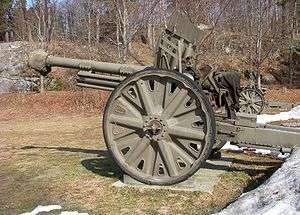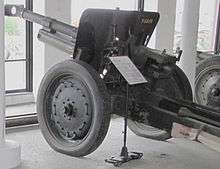Haubits m/40
The 10,5 cm Haubits m/40 is a Swedish 105 mm howitzer, which was manufactured by Bofors during World War II.
| 10,5 cm Haubits m/40 | |
|---|---|
 10,5 cm Haubits m/40 | |
| Type | Howitzer |
| Place of origin | Sweden |
| Service history | |
| In service | 1940-today |
| Wars | World War II |
| Production history | |
| Designer | Bofors |
| Designed | 1937 |
| Manufacturer | Bofors Tampella |
| Produced | 1940 - |
| Variants | 105 H 37 (Finnish version) 105 H 61-37 (modernized Finnish version) 10.5 cm Hb Model 46 (Swiss version) |
| Specifications | |
| Mass | 1,970 kg |
| Length | 5.310 m |
| Crew | 7 + 3 reserve |
| Shell | high explosive |
| Caliber | 105 mm |
| Breech | Horizontal sliding-wedge breech or interrupted screw breech |
| Carriage | Split trail with recoil spades |
| Elevation | -5 to +45 degrees |
| Traverse | 50 degrees |
| Rate of fire | 10 rounds per minute |
| Maximum firing range | 10,900 m |
The howitzer was license manufactured both in Finland and in Switzerland. Today, the gun is mainly used as a training gun by the Estonian army.
Operators

- 105 H 61-37 version. Ca. 40 units from Finland. Used as training guns.

- 105 H 61-37 version. 140 units, now withdrawn from service, ca. 40 were given to Estonia.

- Used in Dutch East Indies

- 10,5 cm Haubits m/40, about 400 units in five versions or alterations.

- 10.5 cm Hb Model 46 version

Versions

An H 61-37 in Hameenlinna Museum
- 10,5 cm Haubits m/40
- Original Swedish version
- 105 H 37
- Finnish version manufactured by Tampella
- 105 H 61-37
- Finnish modernized version from the 1960s. Longer L/26 barrel with redesigned muzzle brake, new equilibrators and fixed ammunition for improved rate of fire.
- 10.5 cm Hb Model 46
- Swiss version manufactured in Thun
Specification
- Era: World War II
- Name: 105 mm Haubits m/40
- Type: Howitzer
- Nation: Sweden
- Manufacturer: Bofors
- Target: General
- Date: 1937
- Production Date: 1940 -
- Service Date: 1940-1990’s
- Numbers Built
- Operators: Siam (today Thailand), Netherlands East Indies (today's Indonesia) and in Finland built under license from Bofors as the m/37, Switzerland built under license from Bofors as 10,5 cm Hb Model 46
- Breech Mechanism: Horizontal sliding-wedge breech or interrupted screw breech
- Barrel: 22 or 24 (Bore 20,2 cal)
- Elevation: -5 to +45°
- Traverse: 50°
- Caliber:105×155 mm
- Carriage: Split trail with spades
- Weight: 1970 kg
- Length: 5310 mm
- Shell Types:
- Action: Case-type separate loading, 6 charges
- Muzzle velocity: max 449 m/s
- Tactical range: 10,5 km
- Maximum range: 10,9 km
- Rate of Fire:
- Crew:7 + 3 reserve
- Transportation: Horse drawn, after 1950 motor traction
- Miscellaneous: Perforated muzzle brake
Ammunition
Variants
gollark: Even gets around the evil Global Interpreter Lock for maximum performance.
gollark: Enterprise-level, fully deterministic execution of random code. Totally secure!
gollark: ```pythonimport itertoolsimport multiprocessing as mchars = [chr(x) for x in range(32, 126)]chars.extend(["\t", "\n"])def generate_for_length(length): return map(lambda chars: "".join(chars),itertools.combinations(chars, length))def generate(): for i in itertools.count(): for s in generate_for_length(i): yield sif __name__ == "__main__": def start(func): proc = m.Process(target=func) proc.start() io_queue = m.Queue(maxsize=128) def printer(): while True: print(io_queue.get()) code_queue = m.Queue(maxsize=128) def generator(): for x in generate(): code_queue.put(x) def executor(): while True: code = code_queue.get() result = None try: result = repr(exec(code)) except Exception as e: result = repr(e) if result != None: io_queue.put(code + ": " + result) start(generator) for _ in range(4): start(executor) printer()```
gollark: Which do you think is slower: the execution or generation of strings?
gollark: ```pythonimport itertoolschars = [chr(x) for x in range(32, 126)]chars.extend(["\t", "\n"])def generate_for_length(length): return map(lambda chars: "".join(chars),itertools.combinations(chars, length))def generate(): for i in itertools.count(): for s in generate_for_length(i): yield sfor x in generate(): try: print(exec(x)) except Exception as e: print(f"{e} from {x}")```
See also
External links
| Wikimedia Commons has media related to 10,5 cm haubits m 40. |
This article is issued from Wikipedia. The text is licensed under Creative Commons - Attribution - Sharealike. Additional terms may apply for the media files.